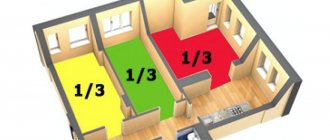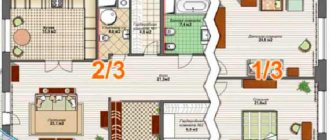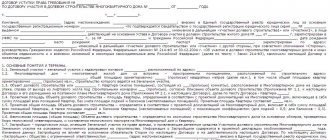Calculator for calculating shares in the right of common shared ownership
Important!
Allocation from common property means the transfer of part of the property in kind by providing ownership of a part of the residential premises corresponding to the citizen, or by paying compensation for it. Legislative framework Regulatory regulation of the procedure for distributing shares between apartment owners is carried out by the following legal acts: Civil Code of the Russian Federation; Housing Code of the Russian Federation; Federal Law No. 218-FZ “On State Registration of Real Estate”; Instructions on the procedure for recording housing stock in the Russian Federation.
How to calculate the share in the right of common ownership of common property
- D – the size of the share in the common property in the apartment building;
- Sкк – the size of the area of communal housing;
- Dкк - size of the share in a communal apartment;
- Soik - the size of the area of all joint property in the apartment building.
- Smkd – the size of the share in the right of common ownership of a land plot;
- Sз – the size of the plot under the MKD (can be found out from the cadastral passport of the land plot);
- D – the owner’s shares in the common property of the apartment building.
How to calculate the share of a land plot
The procedure for determining the shares of land plots located under apartment buildings in the Kamyshlovsky urban district. Implementation of management and disposal of land plots that are in municipal ownership (Part 2 of Article 11 of the Land Code of the Russian Federation), as well as the disposal of plots for which state ownership is not demarcated (Art.
How to calculate the share in the right of common ownership of common property, calculation of the share of a land plot in an apartment building
A land share is considered property of a special nature, which is used for organizing and running a peasant (farm) economy. It represents an area calculated in hectares or points without defining boundaries on the ground. Thus, a land share is a plot of land that is in common ownership of an agricultural plot.
- Ivanova Maria owns ⅓ of the “one-room apartment”, which means: (⅓ * 30 m²) / 1,000 m² = 0.01 shares;
- Igor Losev owns ⅛ of a two-room apartment, which means: (⅛ * 40 m²) / 1,000 m² = 0.005;
- Arina Zakharova owns ½ of a 3-room apartment, and this is: (½ * 60) / 1000 m² = 0.03.
Regarding the apartment, everything is simple - the common property is represented by non-residential premises (kitchen, corridor, pantry, bathroom and toilet). The specified area is divided equally - and by the number of co-owners, and not the size of their shares.
How to calculate shares in an apartment - Online calculator
A special procedure for using a communal apartment is housing with isolated rooms and a common space. Non-residential premises in the form of a kitchen, corridor and bathroom are used by all residents, and specific rooms are used in strict accordance with the allocated share in common law (Article 42 of the Housing Code of the Russian Federation).
The method described above is the simplest. However, it is not suitable for uneven calculation of shares in an apartment. For example, if one of the residents increased the size of his part due to inseparable improvements to the living space (clause 3 of Article 245 of the Civil Code of the Russian Federation). In other words, I hung the wallpaper, replaced the plumbing, turned on the electricity, whitewashed the ceiling, and repaired the holes in the wall.
Calculator for calculating shares in the right of common shared ownership
- General area of the entire house - The total area of all residential and non-residential premises / area owned by the resident. 5300 sq. m. - 4800 sq. m / 165 sq. m.
- Total area of the house / area owned by the resident.
- Extract from the letter of the Ministry of Finance dated December 26, 2006 N 03-06-02-02/154
A share in the ownership of a residential building can be allocated in kind both out of court with the consent of all owners in the house, and through the court if agreement on the terms of the allocation is not reached with other co-owners (Article 252 of the Civil Code of the Russian Federation). It is necessary to take into account that: - unauthorized redevelopment, as well as illegal extensions to the house, are not taken into account when allocating a share in kind until it is legalized (Art.
Corporate law
In the OSS protocol they are required to write down the total area of all residential and non-residential premises of the house, i.e. in our case, 7248.6 sq.m., and the number of owners present as a percentage of this total area, and this ratio determines the presence or absence of a quorum. A little more math. If we take the number of shares of owners or meters of living space (the values are close) to count votes, then if all owners (including city property) are present at the meeting, their shares or meters will be approximately 56% (in the case of shares) and 58% (in the case of sq.m.) Once again - everyone is conditionally present, and the percentage of participation is 56-58%. Hence the conclusion. In the case of communal apartments, in order for the participation of 100% of the owners to correspond to 100% of the votes, each owner must have a number of votes corresponding not to shares in the property and not to meters of living space, but to the sum of the meters of his living space and meters of common areas, i.e. . according to the housing and communal services receipt. But in the register of owners of apartment buildings, shares and meters are indicated according to property documents, and not according to the housing and communal services receipt. How to be?
You may be interested in:: Benefits for labor veterans of the Ivanovo region in 2021
Introduction to English Legal System
As you can see, adding to the “calculations” the area of premises that belong to common property (the inclusion of unknown coefficients through the area of the MOP, that is, common areas: stairs, corridors, basements, etc., is especially popular, judging by my observations) , area of land, dimensions of sanitary equipment, etc. not required. Moreover, such absurd additions and coefficients lead to the fact that the sum of the shares of all property owners deviates from 1 (or 100%). And this, among other things, means that the number of votes of all owners of premises becomes equal to 146%, 69%, or acquires another dubious value.
However, this type of agreement is still one of the subtypes of classic share participation agreements, according to which each acquirer of a share contributes the amount of funds that corresponds to the size of the share he is acquiring.
At this stage, the plaintiff, having received his copy of the court decision that has entered into force, with this document, applies to the territorial divisions of Rosreestr, to which the specific property belongs by location, to obtain a certificate of ownership of his part of the non-residential premises.
How is the part selected?
Most often, this form of shared ownership occurs when forming a list of owners of non-residential premises located in various shopping or office centers, when the owner of the building sells parts of it (offices, offices, space for boutiques) to interested parties.
Accordingly, the concept of “common property” explains that all its residents have the right to joint property in a house. The basis is the right of ownership of individual apartments. It does not matter whether they are in shared ownership or belong to one person.
The calculation of shares applies not only to an individual apartment, but also to common property in an apartment building. And what’s surprising is that there is currently no consensus on the issue of determining shares. Notaries, lawyers, engineers are still confused with the calculation formula. Of course, this is even more difficult for ordinary people to understand.
Why do you need to count shares in the common property of the house?
- Ivanova Maria owns ⅓ of the “one-room apartment”, which means: (⅓ * 30 m²) / 1,000 m² = 0.01 shares;
- Igor Losev owns ⅛ of a two-room apartment, which means: (⅛ * 40 m²) / 1,000 m² = 0.005;
- Arina Zakharova owns ½ of a 3-room apartment, and this is: (½ * 60) / 1000 m² = 0.03.
- D – part belonging to the owner of the property in the right of joint ownership of apartment buildings;
- D1 – part belonging to the owner of the right of ownership of the apartment;
- S1 – size of the apartment area of a particular owner;
- S is the total area of square meters and private non-residential premises in the house.
JavaScript required
How is the share in the right of common ownership calculated in accordance with Article 37 of the LC? If possible, give an example. This is very important because the size of the payment depends on it. It’s just that for some reason I came across several calculation options in the literature, I don’t know which one is correct:
- General area of the entire house - The total area of all residential and non-residential premises / area owned by the resident. 5300 sq. m. - 4800 sq. m / 165 sq. m.
- Total area of the house / area owned by the resident.
- Extract from the letter of the Ministry of Finance dated December 26, 2006 N 03-06-02-02/154 Let us consider, using an example, the procedure for determining the “share in the right of common ownership” of common property in an apartment building, as well as the procedure for calculating the land tax payable by the owner of the premises in this home. Thus, in an apartment building there are 10 two-room apartments with an area of 55 square meters. m each and 10 three-room apartments, each with an area of 80 sq. m. m. All apartments in the building are privatized. On the ground floor of this house there is a store with an area of 150 sq. m. m, owned by Almaz LLC. The cadastral value of the land plot on which this house is located is equal to 1,500,000 rubles, and the tax rate established by the representative body of the municipality in relation to this land plot is 0.3 percent of its cadastral value. To determine the share in the right of common ownership of common property in a given house belonging to each owner of the above premises, we determine the total area of these premises. Store area + area of all two-room apartments + area of three-room apartments = 150 sq. m + (55 sq. m x 10) + (80 sq. m x 10) = 1500 sq. m. m. The share in the right of common shared ownership of common property for each owner of the premises will be equal to the quotient of dividing the area of the premises owned by the taxpayer and the total area of all premises owned by the owners, which in our case is equal to 1500 sq. m. m. Thus, according to the conditions set, the share in the right of common shared ownership of common property will accordingly be: for Almaz LLC 150 sq. m. m: 1500 sq. m = 0.1; for the owner of a two-room apartment of 55 sq. m: 1500 sq. m = 0.04; for the owner of a three-room apartment of 80 sq. m: 1500 sq. m = 0.05. ———————— In general, maybe someone did this? How to calculate correctly. This is necessary for the trial.
How is the regime for the use of property established?
Most often, this form of shared ownership occurs when forming a list of owners of non-residential premises located in various shopping or office centers, when the owner of the building sells parts of it (offices, offices, space for boutiques) to interested parties.
What do you mean by part?
At this stage, the court examines all submitted documents and other evidence that can confirm the legality of the demands put forward and the absence of other possibilities for resolving the existing dispute.
- General area of the entire house - The total area of all residential and non-residential premises / area owned by the resident. 5300 sq. m. - 4800 sq. m / 165 sq. m.
- Total area of the house / area owned by the resident.
- Extract from the letter of the Ministry of Finance dated December 26, 2006 N 03-06-02-02/154 Let us consider, using an example, the procedure for determining the “share in the right of common ownership” of common property in an apartment building, as well as the procedure for calculating the land tax payable by the owner of the premises in this home. Thus, in an apartment building there are 10 two-room apartments with an area of 55 square meters. m each and 10 three-room apartments, each with an area of 80 sq. m. m. All apartments in the building are privatized. On the ground floor of this house there is a store with an area of 150 sq. m. m, owned by Almaz LLC. The cadastral value of the land plot on which this house is located is equal to 1,500,000 rubles, and the tax rate established by the representative body of the municipality in relation to this land plot is 0.3 percent of its cadastral value. To determine the share in the right of common ownership of common property in a given house belonging to each owner of the above premises, we determine the total area of these premises. Store area + area of all two-room apartments + area of three-room apartments = 150 sq. m + (55 sq. m x 10) + (80 sq. m x 10) = 1500 sq. m. m. The share in the right of common shared ownership of common property for each owner of the premises will be equal to the quotient of dividing the area of the premises owned by the taxpayer and the total area of all premises owned by the owners, which in our case is equal to 1500 sq. m. m. Thus, according to the conditions set, the share in the right of common shared ownership of common property will accordingly be: for Almaz LLC 150 sq. m. m: 1500 sq. m = 0.1; for the owner of a two-room apartment of 55 sq. m: 1500 sq. m = 0.04; for the owner of a three-room apartment of 80 sq. m: 1500 sq. m = 0.05. ———————— In general, maybe someone did this? How to calculate correctly. This is necessary for the trial.
You may be interested in:: Tickets for guards 4th category 2021online with changes
Since a share in a non-residential premises does not have the status of a separate independent object, shareholders, if they wish, have the right to separate their share from the common property in accordance with Article 252 of the Civil Code of the Russian Federation, which can be done either by general agreement or by court.
How to calculate the owner's share in the common property of an apartment building
You do not have the right to hand over any squares. if you do not have ownership rights to a separate room - ownership rights confirmed by a certificate of ownership of a room with an area of (let's say) 10 sq.m. . and a 7/20 share in the apartment - you do not have the right to rent it out.
This also correctly correlates with the definition of “share” as such in the literature, in particular, “a share (and any) is a certain ideal category used to designate the scope of rights of a particular person in property owned by several persons and which cannot be divided” – Practice of application of the Civil Code of the Russian Federation, part one / Under general. ed. V.A. Belova. 2nd ed. M., 2011.
Formula for determining the share in the right of common ownership
The share in the right of common ownership of common property and the number of votes that each owner of the premises has is calculated. In the future, this information will be necessary to determine the quorum at the general meeting and during voting.
It is impossible to divide a one-room apartment into separate rooms,
and that is the only reason why it can be divided only by shares in the right of common ownership, since it is impossible to allocate a room in it that will have a separate entrance.
How to calculate the share in an apartment - formula and instructions
Such an apartment is not inhabited by relatives at all, but by people who are strangers to each other, and the allocation of shares is based on the available space. Each share is registered and has its own certificate of ownership for a specific citizen or citizens, if a family lives in it.
We recommend reading: An individual pays the state fee to the court and is a tax agent
Signatures of the parties to the agreement with transcript. Please note that in order to become the owner of a share under an agreement, it must be registered in the register of individuals, and only from the moment of registration it comes into legal force. If an agreement on determining the shares has not been signed, then they are considered equal.
Distribution of shares after the exit of a member of the Company
In the first case, we are talking about the proportional distribution of the company's share. In the second case, what is meant is disproportionate distribution. In this case, a purchase and sale agreement is concluded between the company, represented by its director, and the buyer.
You may be interested in:: Are there benefits for labor veterans on long-distance trains?
When does apportionment occur?
If the participants wish to leave the same ratio of their shares in the authorized capital, they decide on the proportional distribution of the company's share. It is also necessary that when calculating the distribution of shares it is possible to mathematically correctly calculate the new percentage of shares.
Such an apartment is not inhabited by relatives at all, but by people who are strangers to each other, and the allocation of shares is based on the available space. Each share is registered and has its own certificate of ownership for a specific citizen or citizens, if a family lives in it.
How to calculate the share in an apartment in fractions
Hello. Tell me how to calculate shares in the right of common shared ownership. A family of 4 people buys an apartment, and they want to allocate 50% to their son, 20% to their daughter, and 15% to their wife and husband. As I understand it, the son will have 1/2 share, but how to calculate how many shares in fractions the daughter and wife and husband will have?
1. Property owned by two or more persons belongs to them under the right of common ownership. 2. Property may be in common ownership with the determination of the share of each owner in the right of ownership (shared ownership)
or without defining such shares (joint ownership).
Calculation of the share in the right of common ownership formula
The General Meeting has the authority to make decisions on the agenda. The general meeting of owners of apartment building premises is held in the form of direct voting. The general meeting of owners of premises in an apartment building was convened on the initiative of ____________________, apartment No. ____________ (total area of the apartment _____ m3), as one of the owners of the premises of the apartment building. The date and place of vote counting is ________________________________________ (same address).
Why is it necessary? if you only maintain common property, then take option 0.6 All costs for the monthly maintenance of common property are multiplied by 0.6 - this will be the ruble share of maintaining common property proportional to the area of the owner of the premises of 300 sq.m.
How to calculate the share in a communal apartment formula
Firstly, an apartment building cannot be considered as an independent object of property rights, since the premises in it are independent objects of law in an apartment building. The common property of an apartment building is a complex, individual parts of which are not independent objects of law. It is impossible to recognize stairs, walls of a house, roof, elevator, engineering equipment and other parts of a house as independent objects of ownership. The common property of a house is a complex of real estate, and its parts are intended for maintenance, use and access to the premises. The common property of the house is closely connected by purpose with the premises. The share in the right of common ownership of common property in an apartment building always follows the fate of the premises in the house. In this case, the owners of residential premises cannot allocate a share in kind and divide the common property between the owners of residential premises.
Registration of meeting participants 11.1. In the registration sheet of premises owners (see appendix to the minutes of the meeting) opposite the corresponding apartment number (room in a communal apartment) or cadastral number
Project Director for LegalTech innovations and new technologies of the digital economy
Share is an ideal category. Ideal category relative to other owners. This is by no means the actual volume of square meters (especially since, as previously stated, “common property includes a land plot, some premises in an apartment building, and even structures and equipment - that is, a certain complex of objects”). Therefore, the specific composition of common property and its size do not in any way affect the size of the share in the right of common ownership of common property in an apartment building; That’s why it, this share, is proportional precisely to the size of the total area of the owner’s premises (Part 1 of Article 37 of the Housing Code of the Russian Federation).
Introduction to English Legal System
This complex of objects, together with residential and non-residential premises (which do not belong to the common property in an apartment building) constitutes an apartment building in the broad sense, and this apartment building needs management, maintenance, etc. Also for these purposes, the legislator introduces the concept of “share in the right of common ownership of common property in an apartment building.”
Example. Ivan and Mikhail jointly own a three-room apartment, the total area of which is 90 square meters, of which the living area is 70 square meters. Moreover, Ivan’s share is 2 times greater than Mikhail’s share. After three years of living, the neighbors started a major renovation and they were faced with a financial question. Ivan argued that they use the kitchen, bathroom and hallway equally, and accordingly, they should contribute equally to their repairs, while Mikhail, who owns a smaller share, argued that he would pay only in proportion to the size of the parts. Using an online calculator and entering the necessary parameters into it, the co-owners calculated that the size of the shares in the common property right was the same and amounted to ten square meters: (90-70)/2=10. Mikhail had no choice but to agree with Ivan and pay for the repairs equally.
You may be interested in:: Benefits for large families in the Stavropol Territory 2021
How to calculate shares in an apartment - Online calculator
But what to do if the housing should actually be divided between several people who do not plan to share their property with another person in any way, but for some reason are forced to live together in the same premises? Here the calculation is made based on square meters.
Both total and living space are taken into account. The first step is to determine exactly what size a particular room belongs to a particular owner. After this, the size of its part should be determined based on the fact that everyone should receive a separate room. If for some reason one room is larger (or smaller than another) and the share is assumed to be equal, then the owner who received the “advantage” must compensate the difference to the second owner.
Calculation of the share in the right of common ownership formula
The share of the owner of the premises in the right of common ownership of common property in an apartment building is proportional to the size of the total area of the specified premises (Clause 1 of Article 37 of the Housing Code of the Russian Federation). MP "Inventarizer" provides services for providing information in the form of extracts from the register of technical documentation (RTD) for calculating the owner's shares in common property.
According to Article 36 of the Housing Code of the Russian Federation (LC RF) 1. The owners of premises in an apartment building own, by the right of common shared ownership, the common property in an apartment building, namely: 1) premises in this building that are not parts of apartments and are intended to serve more than one premises in this house, including inter-apartment landings, stairs, elevators, elevator and other shafts, corridors, technical floors, attics, basements in which there are utilities, other equipment serving more than one room in this house (technical basements); 2) other premises in this house that do not belong to individual owners and are intended to meet the social and everyday needs of the owners of premises in this house, including premises intended for organizing their leisure time, cultural development, children's creativity, physical education and sports and similar events; 3) roofs enclosing load-bearing and non-load-bearing structures of a given house, mechanical, electrical, sanitary and other equipment located in a given house outside or inside the premises and serving more than one room; 4) the land plot on which this house is located, with elements of landscaping and improvement, other objects intended for the maintenance, operation and improvement of this house and located on the specified land plot. The boundaries and size of the land plot on which the apartment building is located are determined in accordance with the requirements of land legislation and legislation on urban planning. The share of each owner in the common property is determined by dividing the area of the premises (according to the certificate of ownership) by the sum of the areas of residential and non-residential premises in the house, with the exception of common areas. MP "Inventarizator" calculates shares in common property and issues relevant statements.
We recommend reading: Providing housing for young professionals
#1 -Mathematician-
But, in order to register the land plot under the building and to eliminate disagreements between the owners during the repair and maintenance of the building, it was decided to also obtain a certificate from the BTI about what my (and specifically everyone’s) share in the building is.
#4 petroff petroff —>
All areas are taken from the BTI certificate, which is called “certificate on the size of premises in an apartment building.” If it’s not an apartment building, or non-residential property in general, then don’t care. It’s still the same calculation, only the certificate will be different.
In accordance with Part 1 of Art. 37 of the Housing Code of the Russian Federation, the share in the right of common ownership of common property in an apartment building of the owner of the premises in this building is proportional to the size of the total area of the specified premises.
It turns out that the utility service provider must pay the RSO exactly the same amount of the utility resource supplied for the provision of utility services in a non-residential premises without an IPU as was presented for payment to the consumer. In this regard, it seems advisable to include in the resource supply agreement a condition on determining the estimated volume of consumption of utility resources in non-residential premises. By the way, the procedure for determining the volume of supplied communal resources is essential based on the Rules for concluding resource supply agreements. However, this matters if the MKD is not equipped with a control unit. If the house has a collective meter, all calculations are made based on its readings. In this case, if there is no corresponding condition in the contract, the contractor will have to take advantage of the requirements of the legislation of the Russian Federation on water, electricity and gas supply. However, even if there is a public utility in the house, we believe that the RSO needs information on the amount of utility resources supplied to provide utility services to the owners and users of non-residential premises. This is important if the RNO has established separate tariffs for the population: according to paragraphs. “b” clause 22 of the Rules for concluding resource supply contracts, the cost of a utility resource necessary to ensure the provision of a utility service to users of non-residential premises (including the volume of consumption of utility services provided for general house needs payable by these persons) is calculated based on tariffs for the population only in the case if the owners of non-residential premises belong to the category of consumers equal to the population. That is why, according to paragraphs. “d” clause 21 of the Rules for concluding resource supply contracts in the total volume of communal resources supplied to an apartment building, the volume of communal resources used to provide utility services of the corresponding type to owners and users of non-residential premises, and the volume of consumption of utility services provided for general house needs are allocated, payable by owners and users of non-residential premises.
You may be interested in:: Energy Minors Law 2021
Features of settlements for utilities with owners of non-residential premises
Example. In the courtyard area of a residential building, one owner decided to organize paid overnight parking. Residents' opinions on this matter were divided; some agreed with its necessity, because when the cars are looked after, you don't have to worry about them. Other residents opposed it, since the land plot near the apartment building is their joint property, and they are not obliged to pay someone to park their car. It was decided to hold a vote, as a result of which 50 owners voted “for” and only 28 “against”. After the votes were counted in accordance with the size of the shares, it turned out that among those who voted “against” there were many owners of three and two-room houses, while those “for” were mainly owners of one-room houses. As a result, 70% of the votes were “against” paid parking. As a result, the enterprising resident had to abandon his business idea.
One of the important parts of the general property law of multi-family houses is the land under the house and the adjacent plot assigned to a specific house. The owners own this land jointly, and therefore manage it within the scope of their rights. The land and the equipment and structures located on it are in need of repair and maintenance. All apartment owners are given the right to vote and receive responsibilities to take care of landscaping according to the calculation of the share of the land plot.
The calculation of the share in the common property of an apartment building is based on the provisions of housing legislation (Part 1, Article 37 of the Housing Code of the Russian Federation). This article establishes equal rights for property owners according to the amount of personal property. The more area a person owns, the higher the size of the share in the common property.
How to calculate the share in common shared ownership
The calculation of shared ownership is based on the assumption that the total of all parts in the house is 100% or one. Further calculations can be carried out as a percentage (for example, 10%) or in simple fractions (for example, 1/10).
And the share of a particular owner of a premises is the result of dividing the total area of his premises by the sum of the total areas of all premises in an apartment building (which do not belong to the common property in the apartment building).
Calculation of the share in the right to common property in an apartment building
A general list of such property is given in Article 36 of the Housing Code of the Russian Federation, and a similar list is contained in paragraphs 2–9 of the Rules approved by Decree of the Government of the Russian Federation of August 13, 2006 No. 491, namely: 1) premises in this house, not being parts of apartments (I ASK ALL PARTICIPANTS IN THE DISCUSSION TO PAY ATTENTION TO THIS LEGISLATIVE REQUIREMENT) and intended to serve more than one room in a given building, including inter-apartment landings, stairs, elevators, elevator and other shafts, corridors, technical floors, attics, basements in which there are engineering communications, other equipment serving more than one room in a given house (technical basements) (WHY DO EVERYONE REFUSE TO CONSIDER IN THEIR CALCULATIONS THAT THE AREA OF APARTMENTS SHOULD NOT BE CONSIDERED AS COMPOSITION OF THE COMMON HOUSE PROPERTY, BUT ONLY THE AREA OF THE APARTMENT OF A SPECIFIC OWNER WHEN INSTALLED LAZY SHARE PARTICIPANT OSSP MKD); 2) other premises in this house that do not belong to individual owners and are intended to meet the social and everyday needs of the owners of premises in this house, including premises intended for organizing their leisure time, cultural development, children's creativity, physical education and sports and similar events; 3) roofs enclosing load-bearing and non-load-bearing structures of a given house, mechanical, electrical, sanitary and other equipment located in a given house outside or inside the premises and serving more than one room; 4) the land plot on which this house is located, with elements of landscaping and improvement, other objects intended for the maintenance, operation and improvement of this house and located on the specified land plot. The boundaries and size of the land plot on which the apartment building is located are determined in accordance with the requirements of land legislation and legislation on urban planning. Information about the composition and condition of common property is reflected in the technical documentation on the MKD, the basis of paragraphs. 24–25 of the Rules, F dated August 13, 2006 No. 491. When determining the AREA of the common property of the owners of premises in the house, it is necessary to take into account the information contained in the Unified State Register. If there is a discrepancy between the information from the register and the data in the technical documentation, the information contained in the register takes precedence. This is stated in paragraphs 3 and 4 of the Rules, approved by Decree of the Government of the Russian Federation of August 13, 2006 No. 491. The meeting of owners is considered valid if its participants have more than half the votes of their total number (clause 3 of Article 45 of the Housing Code of the Russian Federation ). The decision is considered adopted if it is supported by a larger number of votes (clause 1 of article 46 of the Housing Code of the Russian Federation), with the exception of clause 44 of the Housing Code of the Russian Federation. It is for this reason that the number of votes that each owner of a premises in an apartment building has at a general meeting is proportional only to his share in the right of common ownership of common property in a given house (Clause 3 of Article 48 of the Housing Code of the Russian Federation). Further, according to Part 1 of Article 37 of the Housing Code of the Russian Federation, the share in the right of common ownership of common property in an apartment building of the owner of the premises in this building is proportional to the size of the total area of the specified premises. Therefore - Dear colleagues and participants in this discussion. Based on the above stated legal grounds, please note that I am drawing conclusions - without any personal speculation and it is unclear where the coefficients come from. Therefore, I think it is possible to calculate the “Number of votes that each owner of the premises in an apartment building has according to the results of the OSSP of apartment buildings” by taking into account the following parameters and algorithm:
On the territory of the fenced plot of land there is a separate non-residential building (closed parking lot for 15 cars). Area 375.9 sq.m. The owners of 2 m/m are not owners of mkd, 5 are not members of TSN. Shared ownership, 1/15. How do we relate to MKD, TSN? The land under the A/S building is whose? Our? Or do we only have the right to use? I read on the forum that we can collect our own operating system, make our decisions up to and including allocating our share in kind in accordance with the new law on the status of M/M. Can we join TSN as an individual participant, if we consider TSN as a corporation? If not, then how to count our votes? In the certificates - 1/15 of the share of the entire building. The area of the m/m is very different, it does not appear anywhere, but all the required markings are there, the numbers are indicated on the wall. The roof of the building is flat and usable. According to the plan, there are children's and sports grounds, a recreation area, and a green area. In fact, there is guest parking and owners' parking without a closed parking lot. Whose property is the roof of the building? We are required to pay fees for 1 sq.m. of living space in the house, although there are no such maintenance costs! All repairs are ours. Are they gifts of fate on our heads?
Distribution of shares
contains rules for the distribution of shares in common property rights. The calculation is carried out taking into account the size of the area owned by the participants.
According to, the housing area includes all premises, including auxiliary ones. The exceptions are balconies, loggias, terraces and verandas.
The shares of the participants are not necessarily equal, but each of them has the right to a part in the common property:
- apartments - premises for the household needs of residents;
- apartment building.
obliges owners to ensure the proper condition of residential premises. Therefore, determining the share in the right of common ownership affects the costs of maintaining the property. In apartment buildings this includes:
- mechanical, electrical, sanitary and other equipment located inside or outside the apartment;
- common areas and supporting structures.
As a rule, a separate apartment is intended for living and running the household of one family. With shared ownership, this is not always observed, since the participants may be non-relatives who immediately decide how to determine the share in the common shared ownership.
Common areas in the apartment include kitchens, storage rooms, bathrooms, toilets, and corridors. You can change the size or composition of common property through reconstruction.
Real estate is recognized as divisible with the allocation of a part to each participant only under the following conditions:
- it is possible to provide isolated residential and utility premises to the owners;
- there are several exits or there is a technical possibility of redevelopment.
Only then can the shares in shared ownership of the apartment be calculated in proportion to the area. If, according to technical characteristics, the apartment is indivisible, the parts are indicated as a fraction without division in kind.
Calculation of share size
With equality in shared ownership, the more owners, the smaller the size of the parts. In this case, despite the presence of shares, each meter of housing will be considered common. For example, a 3-room apartment has 2 shared owners, both have the right to ½ ideal share. The calculation of the size of shares in an apartment is carried out taking into account the area of the room. When allocated in kind, one tenant will become the owner of a large room, and the other - two small ones.
If technical parameters allow, redevelopment is possible by agreement of the participants or by court decision.
The powers to own and dispose of property depend on the size of the participants’ shares, so owners are interested in factors that influence changes in the size of their parts of the apartment. An example of calculating the share in the right of common ownership for such cases is given below.










